 |
 |
 |
| |
Update on the prevalence of the 2007 darunavir resistance-associated mutations in samples received for routine clinical resistance testing
|
| |
| |
Reported by Jules Levin
6th European HIV Drug Resistance Workshop
March 26-28, 2008
Budapest, Hungary
Erkki Lathouwers,1 Sandra De Meyer,1 Inge Dierynck,1 Koen Van Der Borght,2 Lee T Bacheler,3 Theresa Pattery,2 Marie-Pierre de Béthune,1 Gaston Picchio4
1Tibotec BVBA, Mechelen, Belgium; 2Virco BVBA, Mechelen, Belgium; 3VircoLab Inc., Durham, NC, USA; 4Tibotec Inc., Yardley, PA, USA
INTRODUCTION
· Resistance to available antiretroviral (ARV) agents in treated HIV-1-infected
populations poses a significant clinical challenge. Routine virological monitoring and characterisation of the development of resistance to new ARVs is important for optimising therapeutic strategies.
· The HIV-1 protease inhibitor (PI) darunavir (DRV; TMC114) has significant in-vitro and in-vivo activity against both wild-type virus and multidrug-resistant HIV-1 strains.1-4 In addition, the high genetic barrier of DRV delays the development of resistance.5,6
· DRV with low-dose ritonavir (DRV/r) at a dose of 600/100mg bid has been approved in the USA in June 20067 and in Europe in February 20078 for the treatment of HIV-1 infection in treatment-experienced adult patients
- it is estimated that there were at least 30,000 patients in total who initiated
treatment with DRV during the June 2006-December 2007 period in the USA and Europe.
· The presence of 33 DRV resistance-associated mutations (RAMs) (based on the 2006 DRV RAMs list) at baseline was associated with a diminished virological response to DRV/r in the POWER studies9
- routine clinical samples with evidence of PI resistance received at Virco BVBA, Mechelen, Belgium before the USA launch of DRV in June 2006 showed a low prevalence of the original 11 DRV RAMS10
- a new analysis based on a larger clinical dataset in highly treatment experienced patients identified an updated list of 11 DRV RAMs (2007 DRV RAMs list) predictive of a diminished response to DRV/r.11
· The objective of this study was to determine the prevalence of DRV RAMs from the updated 2007 DRV RAMs list in routine clinical samples received before and after the US launch of DRV to assess for potential changes in the frequency trends of these mutations.
AUTHOR CONCLUSIONS
· These analyses show that the prevalence of individual 2007 DRV RAMs and incremental counts of the 2007 DRV RAMs among routine clinical samples with
PI resistance remained stable after the launch of DRV.
· The prevalence of the newly added T74P 2007 DRV RAM (individually or in combination with other 2007 DRV RAMs) remained low before and after the
launch of DRV.
· Among samples with PI resistance that were submitted after the US launch of
DRV, approximately 93% (according to the US FDA mutation list) and 91%
(according to VircoTYPE HIV-1 lower CCO) harboured <3 2007 DRV RAMs
and 75% (according to the US FDA mutation list) and 67% (according to
VircoTYPE HIV-1 lower CCO) harboured zero 2007 DRV RAMs.
Methods
· The prevalence of DRV RAMs from the updated 2007 DRV RAMs list was studied in 6-month intervals (semesters) in approximately 98,000 routine clinical samples submitted to Virco between November 2004 and November 2007.
· Among these, approximately 50,700 samples were submitted after the US launch of DRV (last three semesters).
· Samples from research studies and clinical trials were excluded from this analysis.
· The 2007 DRV RAMs list included the following mutations: V11I, V32I, L33F, I47V, I50V, I54L/M, T74P, L76V, I84V and L89V. Compared with the mutations in the 2006 DRV RAMs list, the only change was that G73S was replaced by T74P.11
· Routine clinical samples were grouped according to their level of PI resistance, defined by:
1. any change at amino acid positions 30, 32, 36, 46, 47, 48, 50, 53, 54, 73, 82, 84, 88, or 90 (US Food and Drug Administration [US FDA] mutation list), or
2. a predicted fold-change in IC50 (FC) for any PI greater than the following
VircoTYPE HIV-1 lower clinical cut-offs (CCOs) (VircoTYPE HIV-1 version 4.2.01)
-- atazanavir/r: FC >2.5
- nelfinavir: FC >1.2
-- DRV/r: FC >10.0
- ritonavir: FC >2.1
-- fosamprenavir/r: FC >1.5
- saquinavir/r: FC >3.1
-- indinavir/r: FC >2.3
- tipranavir/r: FC >1.5.
- lopinavir/r: FC >6.1
· The prevalence of individual and combinations of the updated 2007 DRV RAMs was determined during the three semesters preceding and the three semesters following the US launch of DRV.
· The proportion of samples with zero, one, two, and 33 DRV RAMs was determined during the three semesters preceding and the three semesters following the US launch of DRV.
Results
A total of 98,326 sequences of samples submitted to Virco for routine clinical
resistance testing between November 2004 and November 2007 were analysed.
Figure 1 outlines the breakdown of the samples included in this analysis.
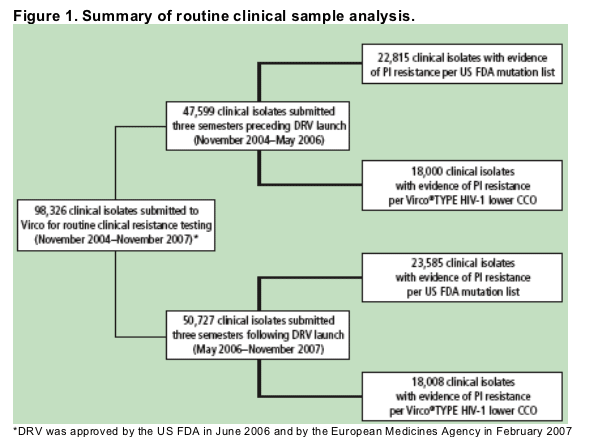
The prevalence of routine clinical samples with evidence of PI resistance according to the US FDA mutation list or the Virco®TYPE HIV-1 lower CCO was similar for samples collected 3 semesters preceding and following the US launch of DRV (47.9% vs 46.5% and 37.8% vs 35.5%, respectively) (Figure 2). After the DRV launch about the same as seen in Figure 2.
Figure 2. Proportion of routine clinical samples showing evidence of PI resistance (per US FDA mutation list or VircoTYPE HIV-1 lower CCO) submitted to Virco during the three semesters preceding and following the US launch of DRV.
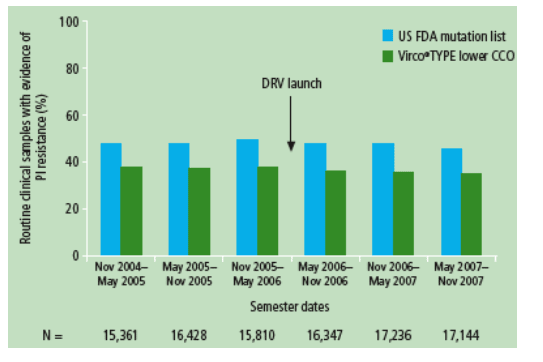
The prevalence of each 2007 DRV RAM was similar during the three semesters
preceding and following the launch of DRV among routine clinical samples with
evidence of PI resistance according to the US FDA mutation list (Figure 3).
Figure 3. Prevalence of individual 2007 DRV RAMs among routine clinical samples with evidence of PI resistance (per US FDA list) submitted to Virco three semesters preceding and following the US launch of DRV.
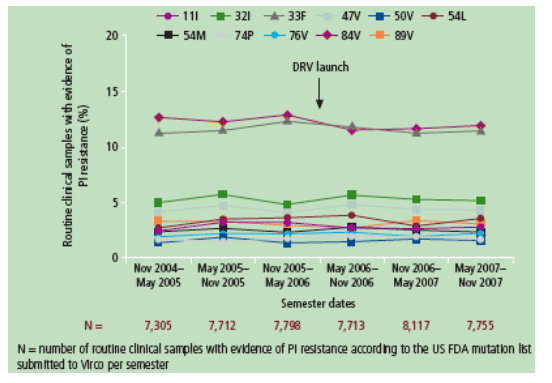
Comparable results were observed in the subset of routine clinical samples with
evidence of PI resistance according to VircoTYPE HIV-1 lower CCO (Figure 4).
Figure 4. Prevalence of individual 2007 DRV RAMs among routine clinical samples with evidence of PI resistance (per Virco®TYPE lower CCO) submitted to Virco three semesters preceding and following the US launch of DRV.
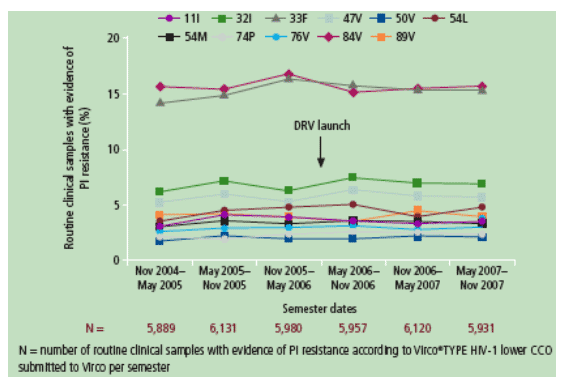
Among routine clinical samples with evidence of PI resistance according to the US FDA mutation list, the proportion of samples with zero, one, two and >/=3 2007 DRV RAMs was similar during the three semesters preceding and following the launch of DRV (Figure 5). The rate of >/=3 DRV RAMS during Nov 04-May 05 was 5.7%, during May 05-Nov 05 it was 6.9%, Nov 05-May 06 6.4% -- after the US launch of DRV - May 06-Nv 06 it was 6.6%, Nov 06-May 07 6.2%, and May 07-Nov 07 it was 6.7%. The differences between before & after launch was the same for zero, one, and two DRV RAMs.
Figure 5. Proportion of samples harbouring zero, one, two or >/=3 DRV RAMs from the 2007 DRV RAMs list among routine clinical samples with evidence of PI resistance (per US FDA mutation list) submitted to Virco three semesters preceding and following the US launch of DRV: a) bar chart b) table.
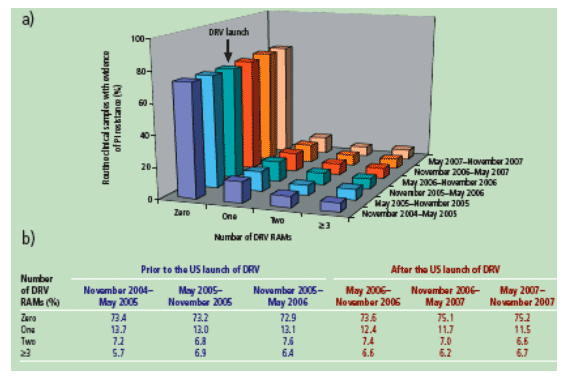
Comparable results were observed in the subset of routine clinical samples with
evidence of PI resistance according to Virco®TYPE HIV-1 lower CCO (Figure 6).
Figure 6. Proportion of samples harbouring zero, one, two or >/=3 DRV RAMs from the 2007 DRV RAMs list among routine clinical samples with evidence of PI resistance (per VircoTYPE HIV-1 lower CCO) submitted to Virco three semesters preceding and following the launch of DRV: a) bar chart b) table.
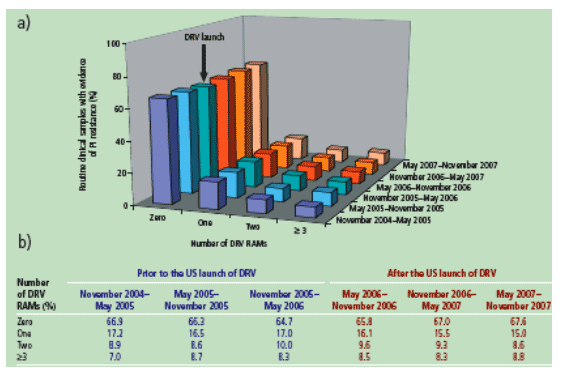
Among routine clinical samples with evidence of PI resistance (per US FDA mutation list or VircoTYPE HIV-1 lower CCO) the frequency of combinations of 2007 DRV RAMs were similar during the three semesters preceding and following the launch of DRV (Table 1).
The most frequently occurring combinations of 2007 DRV RAMs among routine clinical samples with evidence of PI resistance harbouring two or three DRV RAMs are presented in Table 1.
The most common individual DRV RAMs encountered were 33F and 84V (21.6% Nov 04-May 06 and 20.5% May 06-Nov 07).
Table 1. Frequency (%) of combinations of 2007 DRV RAMs occurring in at least 5% of routine clinical samples with evidence of PI resistance (per US FDA mutation list or Virco®TYPE HIV-1 lower CCO) and harbouring two or three 2007 DRV RAMs during the three semesters preceding and following the DRV launch.
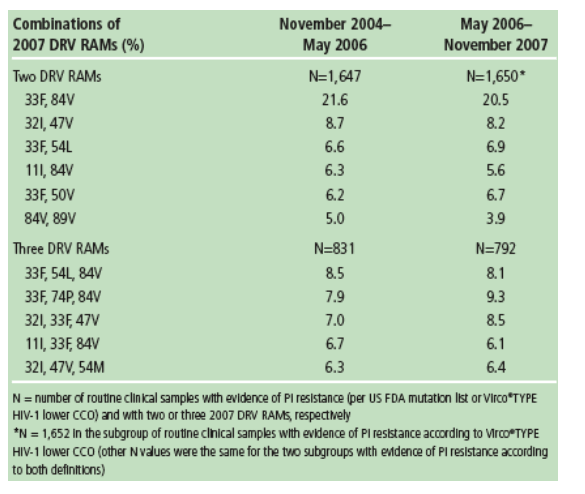
|
| |
|
 |
 |
|
|